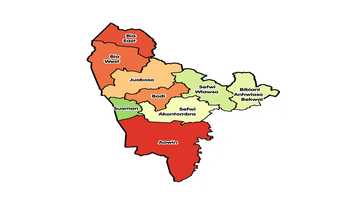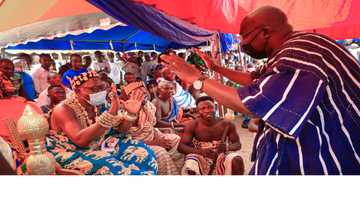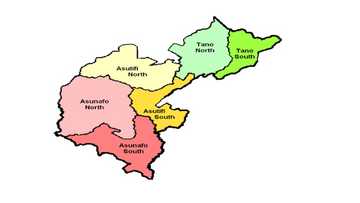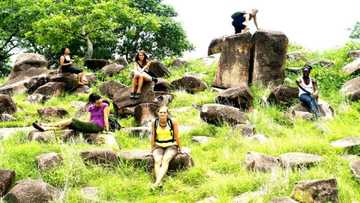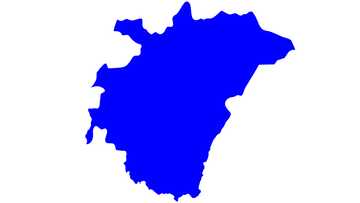The Upper West Region districts, tribes, languages, cultural activities
The rich cultural practices of Ghanaian communities living in the Upper West Region districts attract millions of tourists worldwide. It is the seventh-largest region in Ghana. The districts in Upper West Region of Ghana were fewer in 1988 than in the 21st century because the government split them into 11 districts. The most developed Upper West Region towns are the districts' capitals.

Source: Original
Visiting the tourist attraction areas in the Upper West Region districts of Ghana is fun. Please tour the Jirapa Naa’s Palace, the Hippopotamus Sanctuary at Wechiau, Wa Naa’s Palace, the Gwollu Slave Defence Wall and Slave site caves, Dondoli Sudamic (Larabanga) Mosque, Nandom all-stone Gothic Art Church, and George Ekem Ferguson’s tomb.
Tribes in Upper West Region
There are 1152 communities in the region, and most of them live in rural areas. People rarely consult the judicial system because of its unpredictable outcomes and costs. Traditional chiefs listen and rule over civil cases that concern customary matters, such as land, inheritance, and marriage. Some of the common languages spoken in the Upper West Region are:
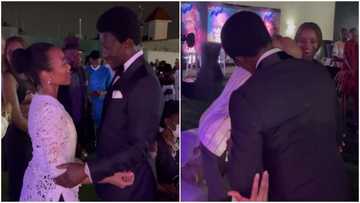
Read also
They looked good: Nana Cheddar seen with Zanetor for first time in 2022; video leaves fans gushing
- Dagaaba in the Eastern part
- Sissala in the Western part
- Wala in Wa and its nearby villages
- Mole
- Dagbon
- Grusi
- Akan
- Dagarba
- Lobi
- Valga
Cultural activities and festivals in the Upper West Region
The people attach special meanings to their festivals. They also wear costumes set aside for the events. For example, women cover heads with distinct local-made clothes and tie long towels that hang from their chests down to the feet while celebrating the Gologo festival. Meanwhile, men wear short knickers and towels on the chests. Common festivals across the region are:
- Kobine
- Foek
- Dzimbi
- Kuure
- Fao
- Golib/ Gologo
- Damba
- Paragbiele
- Adaakoya
- Boaram
The Upper West Region districts
The region has wet and dry seasons. It rains in May and September because of the South-Western Monsoon winds from the Atlantic Ocean. The dry season is between October and April because of the North-Eastern Trade winds from the Sahara Desert. The region is within the Guinea Savannah ecological zone of baobab, kapok, parkia, and shea nut trees. Below are the 11 districts of this region:
1. Daffiama Bussie Issa

Source: Instagram
On 8th June 2012, Nadowlo District was split into Nadwoli Koleo and Daffiama Bussie Issa Districts. Daffiama Bussie Issa's capital town is Issa. The district has three traditional councils and paramount chiefs. The councils are the Issa Traditional Area, the Bussie Traditional Area, the Daffiama Traditional Area.
The two dominant tribes the Dagaaba and the Sissalas make up most of the district's population. The Christians are 51%, Moslems are 36.8%, Traditionalists are 8.3%, and other religions make up 3.7% of the population. The major traditional festivals in the region are the Jimbenti and Dunyee.
2. Nadowli
The district's capital town is Nadowli. The two major tribes here are the Dagaaba and the Sissalas. They are the district's largest population. The Sissalas live in the southern part of the region. Christians dominate the region, followed by Moslems, and lastly, traditionalists.
3. Jirapa Municipalities
On 29th February 2008, the Ghanaian government divided Jipara/ Lambussie District into Jipara District and Lambussie Karni District. Jepara District was renamed Jipara Municipal District on 15th March 2018, and Jipara is its capital town.
4. Larwa
The tribes from this region of Ghana, including Larwa believe in the communal lifestyle. On 28th June 2012, Nandom and Lawra Districts were created from the original Lawra/Nandom District. The government upgraded Lwara to a municipal district assembly on 15th March 2018, and its capital town is Lwara.
5. Lambussie Karni

Source: Instagram
Lambie is the district's capital town. The Sissalas and Dagaabas are the two major ethnic groups in Lambussie Karni. Other tribes in the district are the Moshi, Akan, Wangara, Waalas, Gurunshi, and Fulani. The people have an annual thanksgiving harvest festival in December called Mefele Gbero.
6. Nandom
Nandom is its capital town. Jirapa, Lawra, Nandom, and Lambussie have sparse population settlements with more rural areas than urban areas. Street food is common in urban areas of this region.
Restaurants that sell western food in the villages in the Upper West Region of Ghana are rare. Common meals in those restaurants are sumptuous indigenous dishes. The Dagaras and Sissalas are the main local ethnic communities in the district.
7. Sissala East Municipalities
Sissala, Kasenas, Dagabas, and Moshies are the main tribes in Sissala East. Other ethnic groups make up 2% of its population. FGM was paramount among the indigenous groups. The government split Sissala District into Sissala East and Sissala West Districts. Sissala East became Sissala East Municipal District on 15th March 2018. Tumu is its capital town. Paara Gbiele is a common annual festival in the region.
8. Sissala West
Gwollu is its capital town. Islam is dominant in the district, followed by traditionalists and, lastly, Christians. The people uphold the extended family system whereby most households comprise grandparents, parents, uncles, nieces, etc.
9. Wa East

Source: Instagram
The Wa District was divided into Wa East District and Wa West District in July 2004, and the Wa East was elevated in the same year to Wa Municipal District. The capital town is called Fun. The Dagarba, Lobi, Dagaba, Sissala, Vagla, and the Wa reside in this district. The Wa are mostly Muslims while the Sissala and Dagaba are mostly Christians and animists.
10. Wa Municipalities
The district's capital town is called Wa. The population of Wa is estimated at 100,000 in 2019. The capital has the biggest settlement in the region. Temperatures in the region can reach 410C in March and April before the rainy season begins in late March and ends in October.
11. Wa West
Short and fire-resistant trees interspersed with grass that shed leaves in the dry season are common, and Neem and cactus are also widespread in this area. Wechiau as its capital town and other notable towns in the region include Naaha and Ga. The district was made a municipal district assembly in 2004.
How Upper West Region districts celebrate festivals
The people believe in the gods, rituals, and sacrifices for thanksgiving and averting bad omens. The chiefs and priests intercede for the people to their ancestors. Some of the cultural activities in the Upper West Region are:
1. Golib/ Gologo

Source: Twitter
The pre-harvest festival unites the chiefs and people of the Tongo community in Talensi District at Tong-Zuf hills in March and April (pre-harvest season) to plenty future harvest. Tong-Zuf hills' surrounding regions, Tengzug, Wakii, Yinduri/Zandoya, Gbeogo, Shia, Gorogo, and Spart, also celebrate the festival.
The people offer the Golib god sacrifices and sing traditional songs in the Nnoo shrine. The three-day festival takes place at three different villages, Gorogo (first), Yinduri (second), and Teng-Zug/Tong-Zuf (the final and biggest). The community pours libation at the Teng-Zug shrine to appreciate the gods for a prosperous season.
2. Fao
The Navrongo's chiefs and people celebrate the annual Fao Festival in January. Stalks of millet are displayed as a sign of sacrifice and thanks to the gods. Noise-making and mourning the dead during this festival are prohibited.
3. Feok

Source: Instagram
Feok was first held in 1974, and Foek means an abundance of food in the Buli language. The annual Feok festival happens in December among the Buillsa people of Sandema. It marks the defeat of the Zabarima slave raiders by the Buisla people in the 1880s.
A djerma military leader and jihad warlord of the Zabarima empire named Babatu led the raiders. Dancers from different villages perform with bows and arrows, short axes, shields, and spears to relive scenes from wars.
4. Kuure
The annual Kuure harvest festival by the Zaare community happens in January and February. The people of Tindongsobligo near Bolgatanga call the festival Yalge-Kuure. The Kure (hoe) is the main tool of celebration in this festival. It symbolizes their source of livelihood. The festival begins with sacrifices followed by dancing and drumming
5. Samanpiid

Source: Twitter
The Kusasi community in Kusaug, Bwaku, celebrates the annual Samanpiid harvest festival in November and December to thank God for a bumper harvest. The festival was first celebrated in 1987, and the ex-president Jerry John Rawlings attended the 26th Anniversary as a guest speaker.
6. Adaakoya
The Gurunsis in Bolgatanga and Zuarungu celebrate this annual harvest festival in January and February with sacrifices, dancing, and drumming. Tourists love the experience they have with these communities during the festival.
7. Boaram
In October and November, the Baare community in the Talenis District celebrates the Boaram harvest festival and offers sacrifices to their gods. The Boar community in Talen refers to all the shrines in Tongo with the over lord shrine as the Tenguik-Shrine.
8. Damba

Source: Twitter
It is called Damba (Dagbani), Damma (Mampruli) or Jingbenti (Waali). The Dagbani, Mampruli, and Waali communities in the festival in three sessions; the Somo Damba (10th day of the month of Damba), the Naa Damba (17th day), and the Belkulsi (18th day). The people pray, dance, beat drums, feast, and exchange gifts. The festival marks the birth and naming of the Holy Prophet, Muhammad, which also corresponds to their chieftaincy.
9. Tengana/ Tingana
The ethnic groups in Tongo celebrate the Tengana harvest festival in January by feasting and dancing. The tribe's people are spread across Balungu, Winkongo, Pwalugu, and Tongo regions.
The Upper West Region districts of Ghana are the best place to tour. The people are friendly, peaceful, and accommodating. Moreover, they love learning new things from foreigners. You will have the best time learning their traditions your entire vacation.
Yen.com.gh recently shared about Ahafo Region's cultural activities and tribes. Each tribe in this region has a unique and adorable culture. Foreigners find it easy to adhere to their traditions' dos and don'ts because most of these rules are based on common knowledge.
Taking part in the festivals is the best decision ever. You will get a first-hand experience of how people have fun in a natural and simple environment. Many foreigners fall in love with these traditions and relocate to Ahafo for good.
Source: YEN.com.gh

